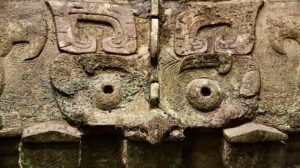
Anyang, located in China’s great North Plain, is a modern industrial city of almost 5.5 million people. It is known economically for the production of iron and steel, coal coking, and clothing production. But long before the modern city arose, the city landscape hosted an ancient urban presence that in time ranked among the world’s great Bronze Age centers. Clues to its remains first began to emerge over a hundred years ago…..
Written on Bone
For hundreds of years, farmers dug them up in their fields near the village of Xiaotun, a small village near Anyang and about 500 kilometers south of Beijing. They were fragments of ox scapula and turtle shell. The farmers sold them to apothecaries, where they were ground into powder for use as tonics or medicines for curing malaria and treating wounds.
But there was another peculiar thing about these bone fragments.
Many of them featured mysterious inscribed markings. In 1899, several of them fell into the hands of Wang Yirong, who was the chancellor of the Imperial Academy in Beijing at the time. Wang collected Chinese bronzes, some of which were Zhou dynasty bronzes inscribed with what he believed to be ancient Chinese writing. The markings on the bone fragments were tantalizingly similar. So similar, in fact, that it wasn’t long before the bone artifacts hit the antiquities trade with a storm and eventually came to the attention of James Mellon Menzies, who conducted the first scientific excavations of the bones, including decipherment. He published the first scientific study of the bones in 1917, which included 2,369 drawings and inscriptions, and eventually amassed a collection of as many as 35,000 objects related to what became known as the “oracle bones”.
Excavation and Discovery of the Lost City
More important than the oracle bones was the drive to find answers to the questions of who made them and why. Scholars were keen to know their context, so in 1928 an excavation team led by Li Ji of China’s Academia Sinica began work near the village of Xiaotun close to modern Anyang, with the initial financial backing and support of the Freer Gallery of Art of the Smithsonian Institution in Washington, D.C. Excavations under Li Ji’s directorship continued with seasons over a 9-year period, recovering more oracle bone artifacts, the decipherment of which showed that the bone inscriptions represented divinations performed by an ancient royal household. Further excavation revealed the remains of a major Bronze Age city, eventually identified by archaeologists as Yinxu, the last capital city of the Shang Dynasty. It was a remarkable discovery, as before the excavation, even the very existence of the Shang Dynasty was in question. Clues to the Shang Dynasty were known only through historical documents. This dynasty was more than a myth.
[To read the full article, subscribe to premium on Popular Archaeology.]
Advertisement

EXPLORE THE ANCIENT ETRUSCANS IN PERSON!
Experience a unique, up-close-and-personal hike among ancient hilltop towns in central Italy. You will walk the sensational countryside of the regions of Umbria and Tuscany, soaking in important sites attesting to the advanced Etruscan civilization, forerunners of the ancient Romans; imposing architectural and cultural remains of Medieval Italy; local food and drink; and perhaps best of all — spectacular scenic views! Join us in this collaborative event for the trip of a lifetime!




